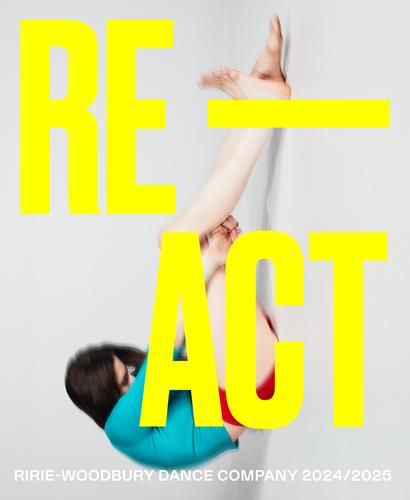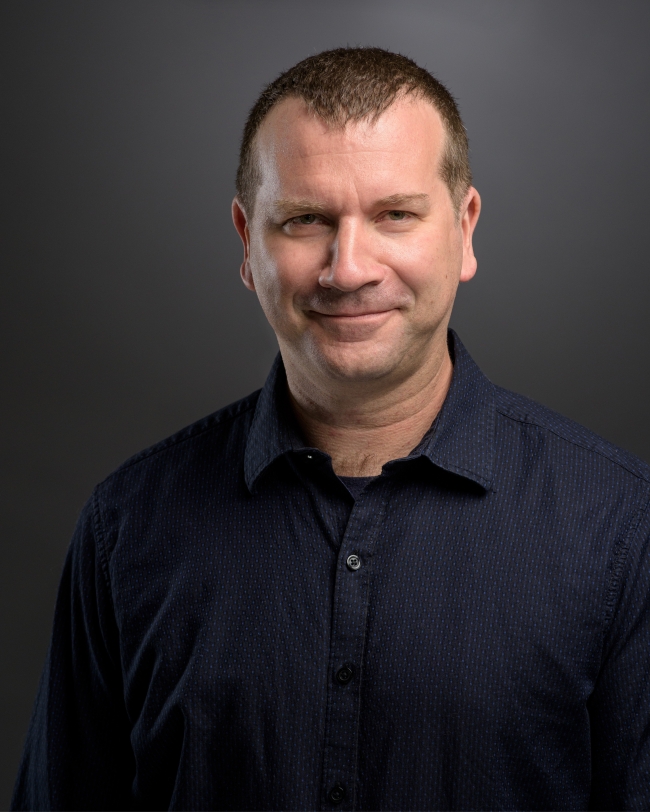With two world premieres, Re-Act, Ririe-Woodbury Dance Company’s closing production for its 61st season, will be a landmark event. It marks the final show for Daniel Charon as artistic director, who is stepping down after 12 seasons. Also, there is the world premiere of A Mischief Sublime by Annalee Traylor, the company’s inaugural Choreographic Canvas Selected Artist.
In From Code to Universe, Charon is not just choreographer and co-creator in this unique piece of dance theater, he also will be on stage as an actor and dancer. Indeed, it is a fitting cap on his exceptional tenure at Ririe-Woodbury. “In leaving the company, I realized that the desire to perform had never been in my work,” Charon said. “This brings a sense of closure that feels really right.”
In the closing moments of this piece, Charon’s dance incorporates snippets from the 22 works he has set on the company during his 12 seasons. Relating an anecdotal example confirming art as a record of memory, Charon said, during rehearsal, he was struck by company dancer Megan McCarthy’s reaction to the closing solo. “McCarthy [who currently has the longest tenure among the dancers] recognized every bit,” he said, adding that it removed whatever sense of insecurity he had about dancing in front of the dancers he has shepherded throughout his time at Ririe-Woodbury.
A multidisciplinary and multimedia piece, From Code to Universe is an engrossing contemplation of human consciousness, embodied intelligence, and deep time as the canvas for contextualizing how even our individual and routine decisions and actions can become consequential and how our memories are threaded into the grand quilt of history.
This is the third time that Charon and Alexandra Harbold, a theatrical director who is on the University of Utah faculty and is cofounder of the Flying Bobcat Theatrical Laboratory, have collaborated on creating new work. Their previous collaborations have also been multidisciplinary and multimedia — The Live Creature and Ethereal Things and To See Beyond Our Time — but this latest work is an apotheosis of sorts. At one point, as Charon said in an interview with The Utah Review, he imagined that the piece would augment the Together Alone trilogy he had set on the company during his tenure. Instead, he and Harbold discussed how this newest work’s cosmological themes, with the shadows of digital technologies and artificial intelligence looming over them, could best be realized. They brought in Utah playwright Connor Nelis Johnson, who had studied with Harbold, to author a script, which he titled Robot Voice. “To celebrate Daniel’s final connection with the company, I knew this piece should be about history, memory and legacy,” Harbold said.
The process of harmonizing the pieces of this collaboration into a cohesive and coherent whole has happened organically. Johnson’s script has a structure that emphasizes how the discrete elements of theater and dance have been melded to symmetrically occur and respond to each other. Featuring all six company dancers, the work also has six characters: two are named specifically (Francis and Adam), two are generally labeled (Teacher and Robot/Student) and two are universally conceived (Someone and Someone Else). Charon takes the role of Adam, while actor Nicki Nixon is Francis. Two Ririe-Woodbury dancers also have roles: Fausto Rivera as Teacher and Miche’ Smith as Someone Else. Ben Young and Mack Barr are, respectively, Someone and Robot/Student.
It is Someone’s task in the script that clearly sets the provenance in this work, by backtracking the timeline in order to understand how humans are no longer formed from clay, but are now being formed in code. The character of Someone explains the resilience of the clay myth, starting from when “the goddess Aruru pinches off a clump of clay to make a human” (from the Epic of Gilgamesh), which is universally evident in mythologies, religions and modern science through the course of human civilization. It is this paradigmatic shift that will be acutely familiar to audiences who might wonder about how the familiar and historical norms of how we have understood sentience and consciousness are being transformed and what that possibly could mean for being human. In his script, Johnson has opened up the space for choreography to become the “intricate wallpaper” in the piece.
Johnson said he was excited to have the opportunity to write text specifically as a foundation for the piece, when the collaboration started last fall. “Daniel [Charon] is interested in the ideas of deep time and time on a geological scale and AI,” he said. “It was extremely liberating for me as a playwright to explore the subject matter and open up avenues that might not have been available for making sense if it was just a play.”
Reading the script, one readily will notice how instinctively Johnson has paralleled the rhythm of the monologues as a natural companion to the choreographer’s movement language. As Johnson noted, he wrote Robot Voice in the vein of the surrealist exquisite corpse method, which removed the onus of the writer to ensure that everything makes sense to the audience. From Code to Universe liberates individual audience members to become detectives to assemble the pieces of the puzzle in whatever way makes the best sense to them.
Johnson added that several weeks before he started writing the script, a family relative died unexpectedly. “Death was at the forefront when I started, as I wrestled with the topic, and what it might look like in the future and what we leave behind,” he said.
”As I thought about technology, I was interested in how origin myths in many cultures are centered on humans coming from clay and how the sense of earth-based creation is being disconnected by moving into the digital sphere.” With that, Someone’s monologue was conceived, which mentions the Library of Ashurbanipal in Assyria, the greatest of its kind in antiquity. More than 32,000 clay tablets and fragments of cuneiform culture have survived.
An Alabama native who now lives and works in Atlanta, Traylor was selected from dozens of submissions that came in for the company’s first Choreographic Canvas Artist commission. An artist-in-residence at Callanwolde Center for Fine Arts in Atlanta, Traylor was awarded Outstanding Choreographer at the Youth American Grand Prix semi-finals. In addition to Ririe-Woodbury, Traylor is premiering new works with Kit Modus, and Terminus Modern Ballet Theater this spring.
Traylor graciously answered questions in email from The Utah Review.
About the Choreographic Canvas call:
I remember seeing the Choreographic Canvas call on social media and immediately became curious and wanted to know more. I remember feeling grateful and excited that the organization had invested in creating a significant, sound opportunity and platform for choreographers to share their work. I became aware of Ririe-Woodbury sometime in 2013/14 when I was seeking employment as a dancer. I auditioned for the company around the same time Daniel Charon had just become Artistic Director. Full circle moment!
Sources of influence and inspiration as a dancer and choreographer
Oh, many artists! To name a few, Sidra Bell, Rosie Herrera, and Zoe Scofield’s work inspires me, and each has directly impacted my ideas surrounding the process. Since moving to Atlanta, performing artist and collaborator Jimmy Joyner has been a perpetual inspiration and profoundly influenced perspectives on artistic ethos and art-making. From afar, David Byrne, Marlene Monteiro Freitas, and Martin Zimmerman’s work has been transformative and life-changing in ways that remain with me daily inside and outside the studio.
About the piece and collaborating with Jesse Scheinin to create an original score to accompany the choreography
In 2019, Jesse and I collaborated on an original score, and I have eagerly anticipated the right opportunity to work with him since. His music is highly evocative, rhythmic, pointed, and lush, making it intensely inspiring, challenging, and sometimes even intimidating! When I received the green light to collaborate with him on A Mischief Sublime, I formally allowed the vision to begin etching… as I wanted to be heavily influenced by his compositions – structurally, energetically, thematically, and aesthetically.
I shared a playlist of reference tracks I considered for the residency, including Chopin’s Nocturne in D-flat Major. This Chopin piece inspired the first draft Jesse sent, which viscerally struck me, and I knew it would be crucial in shaping the piece’s emotional landscape and energetic trajectory. Rhythm and contrast are essential elements in my work, and they were key considerations in how Jesse and I approached our collaboration. Conceptually, these ideas played a vital role in further elucidating themes and symbolism of pursuit.
Working with the dancers at Ririe-Woodbury
Humanity. Connection. Trust. A desire to understand each other and the power in that desire, I believe, manifested what became the final version of A Mischief Sublime. The Ririe-Woodbury artists were so generous with their offerings and contributions to this work; their approach to play, our communication style, and collaborative problem-solving allowed for experimentation and a willingness to venture into the unknown. The relationships that developed throughout the process, the trust-building, and the evident individuality among a cohesive ensemble of artists hold a weighted significance to me.
Performances will take place April 18 and 19 at 7:30 p.m. at the Black Box Theatre at the Rose Wagner Center for Performing Arts. Attendees at the company’s Ultraviolet Night Gala on April 17 will see the first Re-Act performances. In addition, there will be the Moving Parts Family And Sensory Friendly Series performance on April 19 at 1 p.m. For tickets and more information, see the Ririe-Woodbury Dance Company website.





